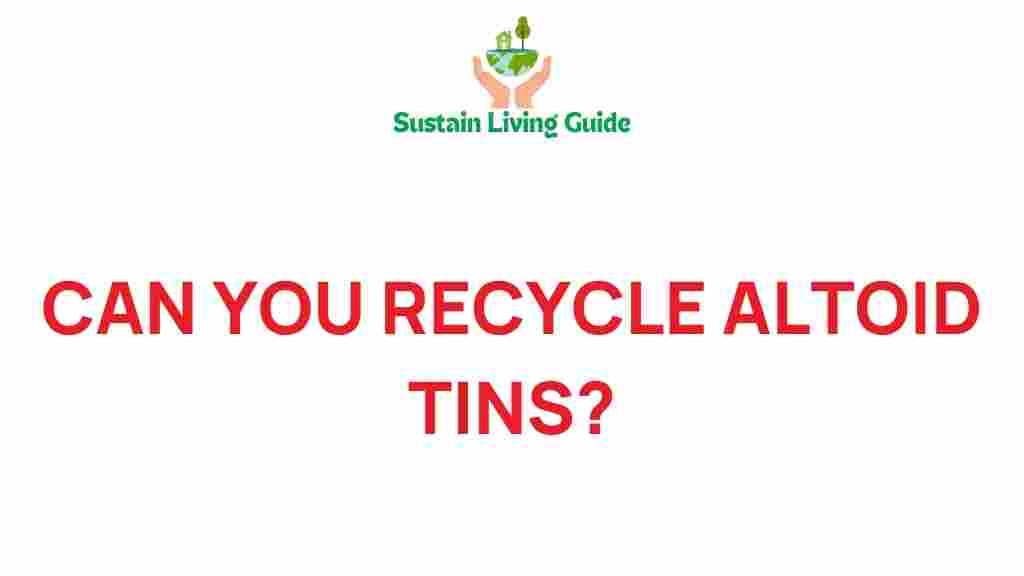The Surprising Truth About Recycling Altoid Tins
Altoid tins are not just a container for your favorite mints; they are a versatile and eco-friendly resource that many people overlook. In recent years, the conversation around recycling has gained momentum, and Altoid tins have emerged as an unexpected hero in the world of sustainable practices. This article will explore the various ways you can recycle and repurpose Altoid tins, along with the environmental impact they have. Whether you’re a crafty DIY enthusiast or simply looking for ways to reduce waste, this guide will provide you with everything you need to know about Altoid tins.
Understanding Altoid Tins
Before diving into the recycling aspects of Altoid tins, it’s essential to understand what they are made from. Most Altoid tins are crafted from tinplate, which is a thin sheet of steel coated with tin. This material is both lightweight and durable, making it perfect for protecting the mints inside. However, this also means that when disposed of improperly, they can contribute to environmental pollution.
Why Recycle Altoid Tins?
Recycling Altoid tins is beneficial for several reasons:
- Environmental Impact: Recycling reduces the amount of waste that ends up in landfills and helps conserve natural resources.
- Versatility: Altoid tins are small, sturdy, and can be used for a multitude of purposes beyond holding mints.
- Cultural Shift: Embracing recycling practices encourages a culture of sustainability and environmental responsibility.
How to Recycle Altoid Tins: A Step-by-Step Process
If you’re ready to make a difference and recycle your Altoid tins, follow these simple steps:
Step 1: Clean the Tins
Before recycling your Altoid tins, it’s crucial to clean them properly. Here’s how:
- Rinse out any leftover mints or residue with warm water.
- Use a mild detergent to scrub the inside if needed.
- Allow the tins to air dry completely.
Step 2: Check Your Local Recycling Guidelines
Recycling rules can vary by location, so it’s important to check your local recycling guidelines. Many communities accept metal containers like Altoid tins in their curbside recycling programs. Visit your local waste management website to find specific instructions.
Step 3: Prepare for Recycling
Once you’ve confirmed that your Altoid tins can be recycled, prepare them for the recycling bin:
- Flatten the tins if possible to save space in your recycling container.
- Make sure no other materials are mixed in with the tins.
- Place the cleaned tins in the designated recycling bin.
Step 4: Consider Repurposing Before Recycling
Before tossing your Altoid tins into the recycling bin, consider how you might repurpose them. Here are some creative ideas:
- Storage Solutions: Use them to organize small items like buttons, beads, or screws.
- First Aid Kits: Create a miniature first aid kit by filling it with band-aids and antiseptic wipes.
- Gift Boxes: Decorate the tins and use them as unique gift packaging.
- Travel Containers: Store small toiletries or spices when traveling.
Step 5: Share Your Success
After recycling or repurposing your Altoid tins, share your experiences! Engage with friends and family about the importance of recycling and the creative uses for these tins. Social media platforms are also great for showcasing your projects and inspiring others. Consider tagging your posts with relevant hashtags to reach a broader audience.
Troubleshooting Common Recycling Issues
While recycling Altoid tins is generally straightforward, you might run into some challenges. Here are some common issues and how to troubleshoot them:
Issue 1: Local Recycling Programs Do Not Accept Metal Containers
If your local program doesn’t accept metal containers, consider collecting your Altoid tins and taking them to a nearby recycling center that does. Alternatively, explore local craft fairs or community groups that might have a recycling initiative.
Issue 2: Difficulty in Cleaning Tins
If you find it hard to remove residue from the tins, try soaking them in warm, soapy water for a few hours. Use a soft sponge to scrub away stubborn spots.
Issue 3: Lack of Ideas for Repurposing
If you’re struggling to come up with creative uses for your Altoid tins, search online for DIY projects. Websites like Pinterest offer countless ideas that can stimulate your creativity. You can also check out this Pinterest page for inspiration.
The Environmental Impact of Recycling Altoid Tins
Recycling Altoid tins contributes positively to the environment in several ways:
- Resource Conservation: Recycling helps conserve raw materials needed to produce new products. For every ton of steel recycled, we save 1.5 tons of iron ore, coal, and limestone.
- Energy Savings: It takes significantly less energy to recycle metals than to produce them from raw materials. This energy savings translates to reduced greenhouse gas emissions.
- Landfill Reduction: By recycling, we can reduce the amount of waste in landfills, prolonging their lifespan and minimizing environmental damage.
Conclusion: Make a Difference with Your Altoid Tins
Recycling Altoid tins is not only a simple way to reduce waste, but it also opens up a world of creative possibilities. By following the steps outlined in this guide, you can make an impact on both your community and the environment. Remember to clean your tins, check local guidelines, and consider repurposing them before recycling. Your small actions can lead to significant changes in promoting sustainability.
So, the next time you finish a tin of Altoids, think twice before tossing it aside. With a little creativity and effort, you can transform these humble containers into something useful while contributing to a greener planet. For more information on recycling and sustainable practices, check out this EPA recycling resource.
This article is in the category Waste and created by SustainLivingGuide Team
